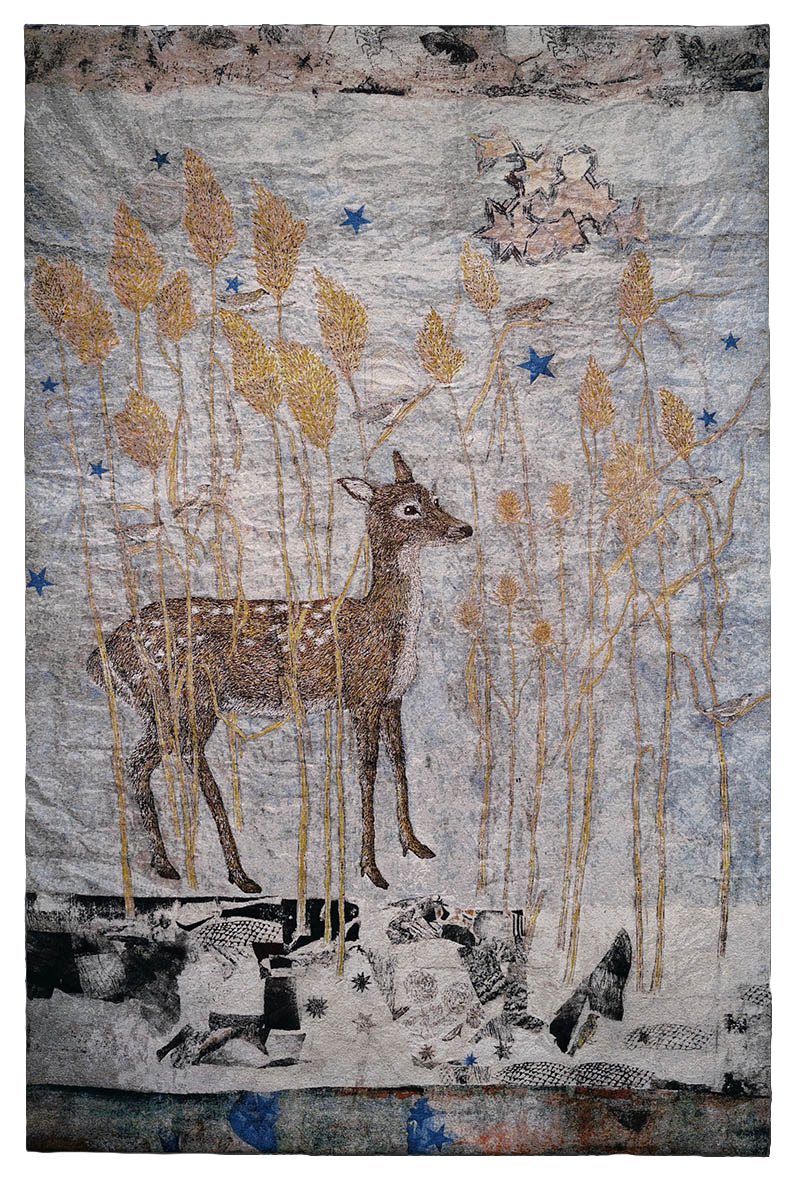Modern Art Oxford volunteer Maria Robertson reflects on her time spent in the galleries surrounded by the works of Kiki Smith. As well as volunteering in the gallery, Maria is also a member of Modern Art Oxford’s Digital Working Group.
As the Kiki Smith exhibition I am a Wanderer draws to a close, I wanted to take time to reflect on my experience of volunteering and invigilating at this exhibition, in an attempt to capture some of the experience for myself and others.
On my first day in the gallery, I found myself standing in MAO’s big generous gallery space, impressed by the sheer scale of the tapestries and looking curiously at a concrete skull with a heavy rusted chain attached to the crown of its head. I imagined myself the ‘wanderer’ arriving in Kiki Smith’s mythical world, the skull an earthy consort on my journey through this intricate forest of weft and weave. I allowed individual tapestries spontaneously to draw me into their individual stories, a body of stars, nature and human forms gathered around me humming with the variance and vitality of life. The large spider web on one of the tapestries snared me, it seemed symbolic of Kiki’s work, a reminder that we are all inescapably part of the same artwork, an intricate web of life. Other tapestries created an expansive and exhilarating mood as birds soared in open sky space above treacherous cliffs.

The next room, and the wonderful ‘cabinet of curiosities’ invited me to really think about the materials Kiki used, glass, bronze, silver and porcelain. These elemental materials brought the mythical world perceptibly into the ‘stuff of life’, the organic now. The perfect glass yolk of an egg in deep ‘embryonic’ orange looked ready to burst, held back by its own materiality. A bronze cast of an empty bird’s nest in the same cabinet, seemed to hint at a darker message of departure from nurture, whilst the bountiful nutrients of the yolk sat ready to feed life. Life and death, death and life. Inescapably intertwined.

The Piper Gallery – Kiki’s room of prints and etchings, gave time to reflect on her work and processes. Many of her sculptures were first born as prints, moving between worlds posed no problem for Kiki Smith, micro to macro, two dimensions to three dimensions. Her ability to bring an intimate and vulnerable sense of being alive in our own mythology seemed evident throughout the exhibition. The large print at the furthest end of the gallery, depicted a young Alice in Wonderland, wading through water followed by an entourage of slightly harried creatures. This fairytale seemed prescient, a young girl, with a curious expression on a mission to save the planet.
It has been interesting to observe how my favourite works have changed over time. Spending time with the tapestries has meant I have been able to observe their detail, and each week has bought a new revelation. I think when my mood was a little darker, I would be drawn towards the darker elements of her work. For example, the large tapestry next to the web of what appears to be a falling body, maybe buried beneath the earth, with tiny ants interwoven throughout, workers of decay and renewal. This tapestry was also populated with an army of rabbits, which made me think of springtime and fecundity, growth amongst decay. This tapestry seemed to embody the cyclic nature of death and renewal, and remind us, we are ourselves woven into this continuous process.
Animals featured across many of the tapestries, and I often found myself drawn to their gaze, they look quite directly at you inviting connection. The wolf, the deer and the wonderful birds all stay with me, invoking a love and appreciation of the creatures we share the planet with. Unexpectedly, one of the most moving of her animal images was an etching of a wolfs paw. The detail of the individual hairs, the intensity of the observation made me feel the connection she had with the animal world.


Lastly, on my penultimate gallery day, I found myself inexplicably drawn to Me in a Corner, a quiet sculpture in a cabinet of a small girl with delicate outstretched hands. As I peered into the cabinet, I was joined by a visitor who stood alongside me. We began to comment on how we had both overlooked this sculpture initially, but for some reason, today it was drawing us into its orbit. We observed the fragile features, and considered how the hands may have been cast from a doll. Her generous open gesture seemed to embody something of Kiki Smith, open and embracing the whole of life, in all its forms, the beautiful and the grotesque, the static and the transient, the earthbound and the spiritual. I loved that this quiet sculpture had brought two strangers together to consider life and our part in it. A testimony to the breadth and philosophical depth of Kiki’s work. The visitors final comment stayed with me … ‘You know, you look a bit like her …’, she commented ‘Who, the girl in the cabinet?’ I enquired … ‘Yes, she said … Kiki Smith’. I think we were both that girl in the corner, feeling a little fragile, but welcoming the world with both hands.

It feels a little sad to be leaving behind this wonderful exhibition, but I am a looking ahead already to spending time with Johanna Unzueta, and her intriguing felt, fabric, cardboard and wood sculptures.
Read more about our exhibition with Johanna Unzueta: Tools for Life here.
